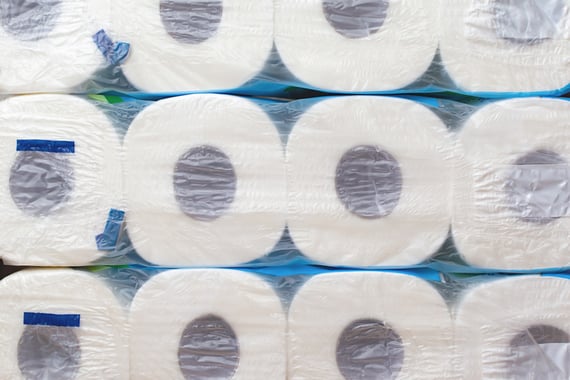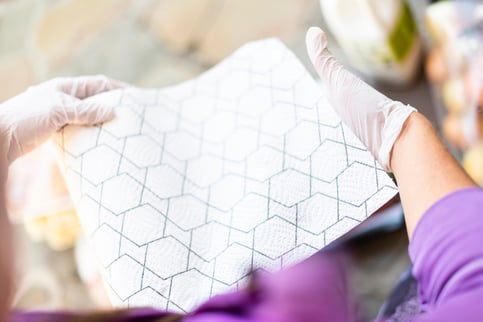Share this
Wide vs. Narrow Web Flexo Printing: The Basics
by Luminite on May 18, 2023 9:28:00 AM

For someone just entering the printing market, one of the most common points of confusion is understanding how printers print on different sizes of substrate. In regard to Flexo printing, there are three main options: narrow, mid, and wide web.
While the basics of all three follow the same set of basic flexography rules, this blog will provide clear details on
- Supplies required for both narrow and wide web printing
- The common uses of wide web printing
- The common uses of narrow web printing
It’s important to have a full understanding of each of these types of flexo printing, their use cases, and the requirements for each.
Flexo Printing: Uses of Wide Web and Narrow Web
At a basic level, the difference between narrow and wide web printing is the size of the substrate in question.
Narrow Web printing can be useful for smaller-sized substrates, while wide web printing is more suitable for larger substrates. Typically, this depends on the industry and the print house.
A narrow web printer may still produce a million impressions, but may only produce several million finished pieces.
Meanwhile, a wide web printer may only run several hundred thousand impressions and produce several million finished pieces.
The choice between Narrow Web and Wide Web often comes down to a few factors, including:
- space for equipment,
- start-up costs,
- the need for inline finishing.
Currently, Narrow Web offers greater versatility for inline finishing (though some of the newer wide web machines are making huge strides here).
Printing Supplies for Wide Web and Narrow Web Printing
Since Wide and Narrow web printing are both functions of flexographic printing, the same rules still apply for each, and the width of your substrate will often determine whether narrow or wide web is appropriate.
Wide vs Narrow Web Press Considerations | Substrates
Substrates can be a variety of materials, including but not limited to:
- Cardboard
- Paper,
- And other pliable materials such as paper towels.
Substrates can consist of more than one layer and can be flexible or rigid, depending on the final product.
Image Carriers
An engraved image carrier is a necessary component of both wide web and narrow printing as well. The image carrier transfers the ink onto the substrate. Elastomer sleeves are ideal for this process, since they are soft, flexible, and don’t require plate breaks. These sleeves also improve reliability when it comes to using solvent-based inks, due to the fact the sleeves don’t swell.
Wide vs Narrow Web Press Considerations | Available Space
Another consideration for wide and narrow web printing is the space you have available. While not necessarily a supply, the space you have available determines whether you can opt for wide or narrow web printing and how many impressions you can see made in a certain timeframe. It also determines how many can be made at a time due to storage considerations.
Pro Tip: For more information on Flexo Printing Materials check out this blog: Flexographic Printing Materials 101: Choosing the Right Materials for Success
Wide Web Printing Provides Speed and Volume
Wide web printing is known for speed and efficiency.
If your order involves a lot of product (think millions of candy bar wrappers or corrugated boxes), wide web printing is the best option to consider. Printing is done on a substrate at least 40 inches wide, and the machine typically operates at 1,000 feet per minute.
Helpful in creating paper towels, consumer goods, and food packaging, wide web printing uses non-toxic, water-based inks that aren’t harmful to the consumer.
While it’s ever-popular in the food industry, the wide-web printing process is also a preferred method to print designs and patterns on pool liners and wallpapers.
While wide-web printing allows for the completion of high-volume orders in a timely manner, wide-web printing presses require significantly more space, which can be an issue for smaller print houses or workspaces.
Narrow Web Printing Provides Specific Finishing Capabilities
Because narrow web presses print on smaller-sized substrates (16” wide or narrower), this style of flexo printing is less space-intrusive than a wide web press.
Commonly found in the pharmaceutical industry, narrow web printing is perfect for small sizes. Narrow web printing is also gaining in popularity in the alcohol industry, as it provides an opportunity to emboss or deboss as the client requires for wine labels and craft beer bottle labels. The embossing and debossing are part of the inline finishing capabilities available through narrow web label printing.
__________________________________________________________________________________________________
Note: Embossing and Debossing are NOT printing technologies or techniques.
__________________________________________________________________________________________________
As mentioned above, UV-curable inks work well for food packaging, and when used for narrow web printing also meet solvent emissions standards. This makes this option of printing more appealing to the environmentally conscious.
If UV-curable inks won't work for your application but you still want to be environmentally conscious, narrow-web printing also works with water-based inks. While the drying times are slower, working with water-based inks allows for a reduction of VOC emissions and a more sustainable/green final product.
From a space and expense standpoint, narrow web printing, when done with UV curable inks, means the process is completed more quickly and eliminates the need for additional equipment for drying purposes.
Wide vs. Narrow Web: Discuss The Options to Determine the Best Choice
Space considerations, ink use, and substrate are only a few of the different variables that can influence your preference in determining if wide web or narrow web printing better suits your product line. Partner with a trusted print house and image carrier supplier to help iron out the various details of the printing process for optimal production.
If you are seeing an issue with flexo printing products, check out our ebook on Flexo printing defects to help identify the issue.
(This blog was originally published in August 2022 and was updated in 2023 to reflect current information.)
Share this
- Flexographic Printing (81)
- Image Carrier (28)
- Elastomer sleeves (27)
- Ink Transfer (25)
- Quality (22)
- Flexo sleeve (20)
- News (18)
- printing defects (18)
- flexo printing defects (17)
- sustainability (13)
- Flexo Troubleshooting (12)
- Ink (12)
- Digital Printing (10)
- Flexo 101 (10)
- Flexo Inks, (9)
- Anilox (7)
- Blister Packaging (7)
- Cost (6)
- print misregistration (6)
- regulations (6)
- Corrugated Printing (4)
- pinholing (4)
- "Tradeshow (3)
- Digital Flexo (3)
- Gravure Printing (3)
- Insider (3)
- Load-N-Lok (3)
- Wide Web (3)
- direct laser engraving (3)
- flexo-equipment-accessories (3)
- gear marks (3)
- halo (3)
- testing (3)
- Narrow Web (2)
- bridging (2)
- feathering (2)
- filling in (2)
- mottled image (2)
- pressure (2)
- Labelexpo (1)
- dirty prints (1)
- doughnuts (1)
- embossing (1)
- kiss impression (1)
- October 2023 (2)
- September 2023 (1)
- August 2023 (1)
- July 2023 (3)
- June 2023 (1)
- May 2023 (5)
- April 2023 (1)
- March 2023 (2)
- February 2023 (1)
- January 2023 (3)
- December 2022 (1)
- October 2022 (3)
- September 2022 (2)
- August 2022 (2)
- July 2022 (3)
- May 2022 (1)
- April 2022 (4)
- March 2022 (2)
- February 2022 (5)
- January 2022 (7)
- December 2021 (1)
- November 2021 (3)
- October 2021 (2)
- September 2021 (1)
- August 2021 (1)
- July 2021 (3)
- June 2021 (1)
- May 2021 (4)
- April 2021 (4)
- March 2021 (4)
- February 2021 (2)
- December 2020 (1)
- November 2020 (1)
- October 2020 (2)
- September 2020 (1)
- August 2020 (3)
- July 2020 (2)
- June 2020 (3)
- May 2020 (1)
- April 2020 (1)
- November 2019 (3)
- October 2019 (1)
- August 2019 (1)
- July 2019 (1)
- April 2019 (1)
- March 2019 (1)
- January 2019 (1)
- October 2018 (2)
- August 2018 (1)
- July 2018 (1)
- June 2018 (1)
- February 2018 (2)
- October 2017 (1)
- September 2017 (2)
- January 2016 (1)
- February 2015 (1)
- January 2015 (1)
- December 2014 (2)
- September 2014 (1)
- February 2014 (1)
- January 2014 (1)
- December 2013 (3)
- October 2013 (1)
- September 2013 (1)
- June 2013 (1)
- January 2013 (1)


Comments (3)